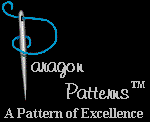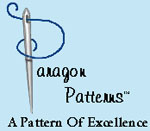| ||||||
| ||||||
|
Tabberone is pronounced tab ber won |
| ||||||||||


|

|
Paragon Patterns Hall Of Shame Member Page Added July 4, 2008 |

|
|
We started out with Paragon Patterns being just one of many craft site listed on the
Craft Sites Page in the Hall Of Shame but we just can't ignore what we would characterize as the most obvious,
blatently self-serving, lying tripe perpetuated by Susan Wigley of Paragon Patterns upon the public. We just had to
give Paragon Patterns their own page. Consider her agenda when you read her garbage.
Susan Wigley of Paragon Patterns has authored several papers in which she makes unsupported and false statements
about sewing patterns as well as licensed fabrics
and embroidery designs.
In a piece dated August 28th, 2007, titled Copyrights and the Sewing Industry,
she makes the following false statements about patterns:
In a follow-up piece titled Copyrights and the Sewing Industry Part 2,
Susan Wigley makes the following false statements about licensed fabrics and embroidery designs:
This page isn't about disagreeing with someone's opinions. The Susan Wigley is flat wrong and she is deliberately contributing
to the manufacturer (and in some cases the designer) misinformation concerning copyright restrictions. Considering all of the end-products from patterns being sold
on the internet and at craft shows, there are NO federal court cases on the issue that we have been able to locate. Pattern companies are not stupid enough to sue
over such an obvious losing issue.
|


|
Rebuttals
In an effort to provide a balanced view, we make the following offer to anyone who feels they have been wrongly accused on this web site. If you, or your company, have been referenced on these pages, and you would like the chance to post a rebuttal, we will post your rebuttal (provided it is in good taste) so others can read it. The rebuttal must be submitted in a format that can easily be converted into HTML. We reserve the right to alter the rebuttal to make it more readable. However, we will not alter the content (unless there is offensive material to be removed). We also reserve the right to comment on any rebuttal received. Emails protesting the content of this web site may be treated as rebuttals by us at our discretion. |
|
General Articles | Cease and Desist Letters | Federal Court Cases | FAQs & Whines | Glossary | Hall Of Shame | Contributions
Corporate Lawyers |
|
Definitions |
|
Federal Court Cases Alphabetically | by Federal Circuit | by Subject | by Court Quotations |
|
Federal Statutes Copyright Act 17 U.S.C. 5 | Digital Millenium Copyright Act 17 U.S.C. 12 | Lanham Act 15 U.S.C. 22 |
|
VeRO (Verified Right's Owner Program) VeRO Commandments | VeRO-Verified Rights Owners Program | Counter Notice Letter Counter Notice (pre-2003) | Counter Notice present | On-Line Survey from 2004 | Articles about VeRO | What To Do If You Are Veroed |
| Original material by Karen Dudnikov & Michael Meadors is © 1999-2017 |